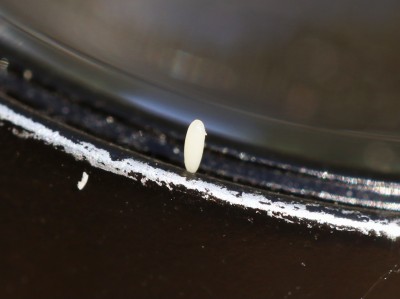Yes they’re really pretty straightforward David - it’s not a difficult species to find if you’re in the right place.
Indeed Wurzel - if you’re after some horror writing inspiration, you need only get the hand lens out and look in your own back garden……
I spent some more time wandering around my study site last week, not part of a thorough search, but just checking on some of the peripheral areas that look reasonable, but have not, so far, hosted larvae.
As expected I drew a blank for most of the day, but as the school pick up loomed and I was about to trudge back to the car I was delighted to find an L3 larva exactly where it should be. A low hanging straggly grey willow branch tucked away in half shade behind a ride side tree and producing those lovely tender leaves that egg laying mothers know their offspring will thrive on.
This was a very satisfying find, as I’ve always thought that l
should find larvae here. There’s no point searching the area more thoroughly until I can use silked-on leaves, but now I know at least one egg laying female passed this way, I will look forward to searching the area so much more.
I also checked on the swollen white admiral caterpillar and found this:
Trying to get the distance right between hand lens and subject, and my phone and hand lens seemed problematic for my poor brain, so this was the best I managed. I decided to take it home to have a closer look:
I then decided to peel away the caterpillar skin to try and see the foreign body as a whole and inadvertently removed the outer sheath to reveal the sticky inner object.

I’m a bit unsure as to what has gone on here, so any thoughts would be much appreciated. As I mentioned in my previous post, I was half expecting this larva to be parasitised, but having never reared or thoroughly observed white admiral before, I can’t be sure what has happened in this case. If this is some sort of parasitoid then it seems too small to account for the difference between the swollen larva, and the hollow remains that were later found, but perhaps there were several and this was the only one that remained within the host carcass? It doesn’t really seem like a parasitoid pupa though - rather more like an egg. Or perhaps something else entirely? I even wondered if this could be a shed skin, with the larva making a doomed attempt at completing its development? This seems unlikely, but with no experience of white admiral I can’t really compare these remains with a recently shed L3 skin. Either way, with no leaves left on that particular honeysuckle, the larva has certainly come to the end of his journey.
Around the woods late season red admirals and large whites were the most frequently encountered butterflies.